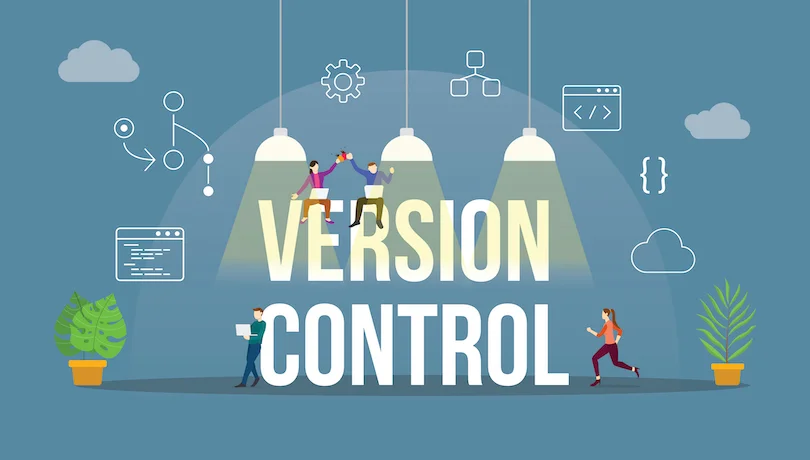
Introduction to Version Control

Version control systems (VCS) are indispensable tools in modern software development, providing a structured method for managing changes to source code over time. At its core, a VCS allows developers to track modifications, revert to previous states, and collaborate efficiently with team members. The fundamental concepts of version control include repositories, commits, branches, and merges.
A repository, or “repo,” is the central storage location where all the files and their history are maintained. Repositories can be local, residing on a developer’s own machine, or remote, hosted on platforms like GitHub or GitLab. Each change to the codebase is captured in a “commit,” which serves as a snapshot of the project’s state at a given point in time. Commits are accompanied by messages that describe the changes made, aiding in tracking and understanding the evolution of the project.
Branching is another critical feature of version control systems, allowing developers to diverge from the main codebase to work on features, bug fixes, or experiments independently. This ensures that the primary branch remains stable while new developments are being integrated. Once a feature is complete or a bug is fixed, the changes can be merged back into the main branch, often after a review process to maintain code quality.
The benefits of using a VCS extend beyond mere change tracking. They provide a comprehensive history of the project, enabling developers to understand the rationale behind each modification. This historical context is invaluable for debugging and auditing purposes. Furthermore, version control systems foster collaboration by allowing multiple developers to work on the same project simultaneously without overwriting each other’s work, thereby enhancing productivity and reducing conflicts.
In essence, version control is a foundational practice in software development, ensuring that projects are well-organized, traceable, and collaborative. By mastering these basic concepts, teams can significantly improve their workflow and project outcomes.
GitHub has emerged as a pivotal platform in the realm of software development, fundamentally transforming how developers collaborate and manage projects. At its core, GitHub is a web-based interface that utilizes Git, an open-source version control system, to help developers track changes in their code. This powerful combination allows for seamless collaboration, even among geographically dispersed teams.
One of GitHub’s primary features is the repository, or “repo.” A repository serves as a storage space for project files, including code, documentation, and other resources. It captures the entire development history, making it easy for developers to revert to previous versions if needed. Repositories can be public, allowing anyone to view or contribute, or private, restricted to specific users or teams.
Another integral feature is the pull request. When a developer completes a set of changes, they can submit a pull request to merge their modifications into the main project repository. This initiates a review process where team members can discuss the changes, add comments, and suggest improvements before the code is merged. This structured workflow ensures that only high-quality code is integrated into the project, maintaining the integrity and functionality of the application.
Issues are another powerful tool within GitHub. They enable team members to track tasks, enhancements, bugs, and other project-related activities. Issues can be assigned to specific developers, labeled for better organization, and linked to pull requests, providing a comprehensive overview of the project’s status and priorities.
GitHub Actions, a more recent addition, further enhances the platform’s capabilities by automating workflows. Developers can define custom workflows that trigger specific actions, such as running tests or deploying code, in response to events like push commits or pull requests. This automation streamlines repetitive tasks and ensures consistent processes, ultimately boosting productivity.
GitHub’s collaborative features allow multiple contributors to work on the same project simultaneously without stepping on each other’s toes. By leveraging branches, each developer can work on their own isolated environment, merging their changes only when they are ready. This branching model, coupled with the robust review and issue-tracking systems, makes GitHub an indispensable tool for modern software development teams.
Setting Up Your First GitHub Repository
Creating and setting up your first repository on GitHub is an essential step towards effective collaboration and version control. Follow these instructions to get started with your first repository.
First, log in to your GitHub account. If you do not have an account yet, you will need to sign up for one. Once logged in, click on the “+” icon in the top right corner of the GitHub interface and select “New repository.”
Next, you will be prompted to enter details about your new repository. Choose a name for your repository that is descriptive and relevant to the project. You can optionally add a description to provide more context about the repository’s purpose. Decide whether your repository will be public or private. A public repository is accessible to anyone, while a private repository restricts access to specific users.
It’s generally a good practice to initialize your repository with a README file. The README file is a markdown file that provides an overview of your project, explains how to set it up, and often includes usage instructions. Including a README file at the initialization stage ensures that your repository starts off organized and informative.
Once you have filled in the necessary details, click “Create repository.” Your new GitHub repository is now set up and ready to use. To start working on your project locally, you will need to clone the repository to your local machine. Click on the green “Code” button and copy the URL provided. Then, open your terminal or command prompt and run the following command:
git clone [repository URL]
Replace “[repository URL]” with the URL you copied. This command will create a local copy of your repository on your machine. Navigate into the repository directory using cd [repository name].
To make your first commit, create or modify a file within your local repository. For example, you could update the README file. After making changes, stage the files by running:
git add .
Then, commit the changes with a message describing what you did:
git commit -m "Initial commit"
Finally, push your changes to GitHub with:
git push origin main
Following these steps, you have successfully set up your first GitHub repository, cloned it to your local machine, and made your first commit. Adhering to best practices for repository management and organization, such as maintaining a clear structure and informative README, will facilitate smoother collaboration and more efficient version control.
Collaboration Workflows with GitHub
Effective collaboration on software projects is crucial for success, and GitHub offers a variety of workflows to facilitate this. One of the fundamental workflows is forking and cloning repositories. Forking allows developers to create their own copy of a repository, which they can modify without affecting the original project. Once changes are made, cloning the repository to a local machine enables further development and testing in a familiar environment.
Creating branches is another essential workflow. Branches enable developers to work on new features, bug fixes, or experiments in isolation from the main codebase. This practice ensures that the main branch remains stable and production-ready. When the development on a branch is complete, it can be merged back into the main branch, often through a pull request. Submitting a pull request initiates a code review process, where team members can review the changes, discuss potential issues, and suggest improvements. This collaborative review process helps maintain high code quality and consistency across the project.
Resolving merge conflicts is an inevitable part of collaboration. Conflicts occur when changes from different branches contradict each other. GitHub provides tools to identify and resolve these conflicts efficiently, ensuring that the final merged code is coherent and functional. It’s crucial to address conflicts promptly to avoid blocking progress and maintain a smooth workflow.
Maintaining a clean and efficient workflow within a team involves adhering to best practices. Regularly synchronizing branches with the main branch helps keep the codebase up-to-date and minimizes conflicts. Clear and descriptive commit messages enhance traceability and make it easier for team members to understand the history of changes. Additionally, establishing coding standards and guidelines ensures consistency and readability across the project.
By leveraging these collaboration workflows, teams can work together seamlessly, integrate new features rapidly, and maintain a high-quality codebase. GitHub’s robust set of tools and practices empowers development teams to collaborate effectively, fostering innovation and productivity.
Introduction to Data Version Control (DVC)
Data Version Control (DVC) is a specialized version control system designed to address the unique challenges of managing machine learning projects. Unlike traditional version control systems that focus primarily on code, DVC offers robust support for data versioning, making it indispensable for data-intensive projects. Traditional version control tools like Git are excellent for tracking changes in text files, but they fall short when it comes to handling large datasets and binary files. This is where DVC steps in, providing a comprehensive solution for versioning data, managing pipelines, and tracking experiments.
At its core, DVC provides data versioning capabilities, enabling users to track changes in their datasets over time. This allows machine learning practitioners to maintain a history of their data, facilitating easier collaboration and ensuring reproducibility of experiments. By storing metadata and file hashes in Git repositories, DVC ensures that large data files do not bloat the repository, while still maintaining a reliable version history.
Another key feature of DVC is its pipeline management. DVC pipelines allow users to define and manage complex workflows in a straightforward manner. Each step of the machine learning process, from data preprocessing to model training and evaluation, can be explicitly defined and tracked. This ensures that every experiment is reproducible, as the exact sequence of steps and their dependencies are documented and versioned.
Experiment tracking is another critical aspect where DVC excels. By integrating with Git, DVC enables users to keep track of different experiment versions and their outcomes. This makes it easier to compare results, understand the impact of changes, and make informed decisions about model improvements. Experiment metrics and parameters can be recorded and visualized, providing insights that are crucial for iterative model development.
In summary, DVC addresses the limitations of traditional version control systems in the context of machine learning. Its features for data versioning, pipeline management, and experiment tracking make it an essential tool for any data-intensive project. By incorporating DVC into your workflow, you can ensure that your data and experiments are well-organized, reproducible, and scalable, ultimately leading to more efficient and effective machine learning development.
Integrating DVC with GitHub
Integrating DVC with GitHub empowers teams to efficiently manage and version control their machine learning projects. To begin, you need to set up a DVC repository. First, ensure that DVC is installed in your environment. If not, you can install it via pip: pip install dvc. Navigate to your project directory and initialize a DVC repository using dvc init. This command sets up the necessary DVC files and directories.
Tracking data files and models with DVC is straightforward. Use the dvc add command to track large data files, datasets, or machine learning models. For example, dvc add data/dataset.csv will create a corresponding .dvc file, which is a lightweight placeholder. These .dvc files should be committed to your GitHub repository, while the actual data files are stored in remote storage, keeping your repository clean and lightweight.
Pushing and pulling data from remote storage is crucial for collaboration. Configure a remote storage location using dvc remote add -d myremote s3://mybucket/path. You can push your tracked data to this remote storage with dvc push and pull the data with dvc pull. This setup ensures that all collaborators have access to the necessary data without bloating the GitHub repository with large files.
Automating workflows involving DVC and GitHub can significantly enhance productivity. GitHub Actions allows you to create custom workflows triggered by events such as push, pull requests, or manual triggers. A typical workflow might involve setting up the Python environment, pulling the latest data with dvc pull, and running your machine learning pipeline. Here is a basic example of a GitHub Actions workflow:
name: DVC Workflowon: [push]jobs: run-dvc: runs-on: ubuntu-latest steps: - name: Checkout repository uses: actions/checkout@v2 - name: Set up Python uses: actions/setup-python@v2 with: python-version: '3.8' - name: Install DVC run: pip install dvc - name: Pull DVC data run: dvc pull - name: Run pipeline run: python run_pipeline.py
This workflow ensures that every push to the repository triggers the DVC data pull and pipeline execution, maintaining the integrity and consistency of your machine learning project. By leveraging GitHub and DVC together, teams can achieve seamless version control and collaboration, paving the way for more efficient and scalable machine learning development.
Best Practices for Collaborative Machine Learning Projects
Effective collaboration in machine learning projects necessitates a structured approach to communication, data management, dependency handling, and reproducibility. Utilizing tools like GitHub and DVC can streamline these processes, ensuring that team members can work efficiently and cohesively.
Firstly, clear and consistent communication is paramount. Establishing regular meetings and using communication platforms like Slack or Microsoft Teams can keep everyone aligned. Documenting project goals, milestones, and individual responsibilities in a shared repository on GitHub encourages transparency and accountability. Use GitHub’s Issues and Projects features to track tasks and progress.
Maintaining data integrity is critical in collaborative environments. DVC (Data Version Control) is an excellent tool for versioning datasets and models. By storing large files outside Git repositories and tracking their versions with DVC, teams can avoid common pitfalls like data corruption or loss. It’s essential to establish a protocol for data handling, including naming conventions, data preprocessing steps, and storage locations.
Managing dependencies is another crucial aspect. Using a virtual environment (e.g., virtualenv or conda) ensures that all team members work with the same libraries and software versions. Document these dependencies in a `requirements.txt` or `environment.yml` file, and commit these files to your GitHub repository. This practice helps in setting up the development environment consistently across different systems.
Ensuring reproducibility of experiments is fundamental for validating results and facilitating collaboration. Keep detailed records of experimental setups, including data sources, preprocessing steps, model parameters, and evaluation metrics. Using DVC, you can track these parameters and link them to specific code versions in GitHub. This linkage creates a clear lineage of experiments, making it easier to replicate and build upon previous work.
A successful project structure typically includes separate directories for data, scripts, notebooks, and results. For instance, a common setup might have a `data/` directory managed by DVC, a `src/` directory for source code, a `notebooks/` directory for Jupyter notebooks, and a `results/` directory for output files. This organization helps maintain a clean and navigable repository.
In summary, adopting best practices for collaborative machine learning projects using GitHub and DVC can significantly enhance productivity and project outcomes. By focusing on effective communication, data integrity, dependency management, and reproducibility, teams can ensure a smooth and successful collaboration experience.
Conclusion and Further Resources
In this blog post, we have delved into the essentials of mastering collaboration and version control with GitHub and DVC. By leveraging GitHub, teams can seamlessly manage their code repositories, track changes, and collaborate effectively. Similarly, DVC extends these capabilities to data and models, ensuring reproducibility and efficiency in data science projects.
The integration of GitHub and DVC offers a robust framework for version control that addresses the unique challenges posed by code and data management. Utilizing these tools not only enhances collaborative efforts but also ensures that every team member can contribute efficiently, reducing the risks of conflicts and data loss. The ability to track the lineage of your data and models with DVC, alongside the code versioning offered by GitHub, creates a comprehensive environment for project management.
For those looking to deepen their understanding and skills in using GitHub and DVC, numerous resources are available. The GitHub Documentation provides extensive guides and tutorials on managing repositories, using Git commands, and leveraging advanced features. Similarly, the DVC Documentation offers detailed insights into data versioning, pipeline creation, and best practices for integrating DVC into your workflow.
Additionally, engaging with the vibrant communities surrounding these tools can provide invaluable support and knowledge sharing. Platforms like GitHub Community Forum and the DVC Community are excellent places to connect with other users, seek advice, and stay updated on the latest developments.
By embracing GitHub and DVC, teams are well-equipped to tackle the complexities of modern development and data science projects. These tools not only streamline collaboration but also ensure that every aspect of your project is meticulously controlled and versioned, paving the way for greater innovation and success.
Discover the Top 10 Platforms to Maximize Your Earnings
“`html The landscape of earning platforms has expanded significantly in recent years, offering individuals myriad…
Mastering the First Impression: Your intriguing post title goes here
Engaging Introductions: Capturing Your Audience’s Interest The initial impression your blog post makes is crucial,…
The Art of Drawing Readers In: Your attractive post title goes here
Engaging Introductions: Capturing Your Audience’s Interest The initial impression your blog post makes is crucial,…





